1/ Overview
Collagen is a member of a family of structural proteins whose main function is to provide mechanical resistance to stretching, while keeping body tissues supple and firm. It is also involved in other essential biological processes such as cell adhesion and migration.
It is one of the most abundant proteins in the animal kingdom: it alone represents 90% of the macromolecules making up the extracellular matrix. Secreted by the cells of connective tissue, it is present in most tissues (bone, cartilage, tendons, etc.). It represents about 30% of the total protein mass of the human body, including more than 70% of the dry weight of the dermis.
In humans, there are 28 types of collagen with structures, molecular organizations, tissue distributions and biological functions that can be very diverse. However, all these collagen types have the same structural specificity: their chain of amino acids is made up of a repetition of the same pattern consisting of glycine (“GLY”) and two other variable amino acids (frequently proline “PRO” and hydroxyproline “HYP”), see diagram below.
The repetition of this amino acid pattern forms a peptide chain of more than 1000 amino acids, called the α chain. Several α chains can combine with each other to form a triple helical structure. This combination of three α chains can occur in different ways so that each collagen type has its own structure, giving it particular properties and thus explaining the different tissue distribution depending on the collagen type.
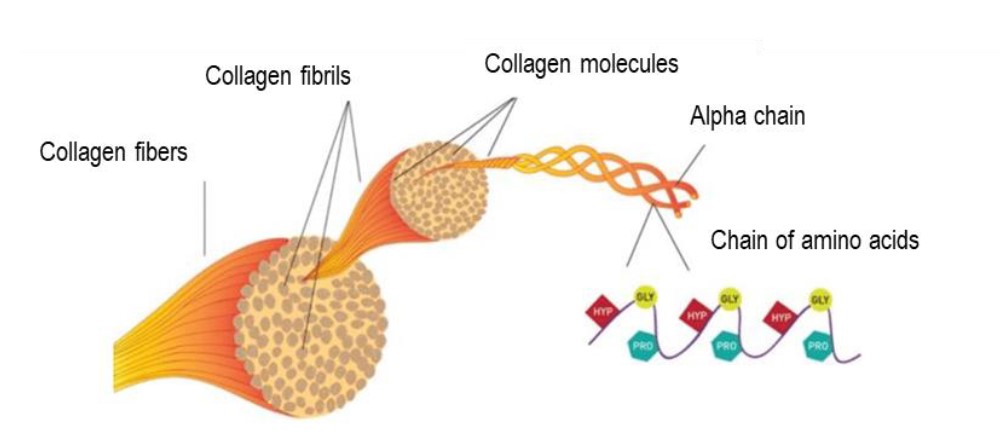

2/ Fibrillar and non-fibrillar collagens
Among all types of collagen, a distinction is made between fibrillar and non-fibrillar collagens. As their name indicates, fibrillar collagens are capable of combining to form fibrils. These form a network that is responsible for the mechanical and morphological properties of tissues. Fibrillar collagens, types I and III, constitute more than 90% of the skin’s collagen content and are the main determinants of tissue strength and rigidity.
Conversely, non-fibrillar collagens differ from other collagen types by the presence of non-collagenous domains. In other words, they have a varying number of interruptions in their triple helices. These serve additional functions and allow these collagens to combine to form complex patterns. Although their total content is low, these collagens play key roles in the ECM’s organization, such as basement membrane formation and adhesion, fibrillar collagen assembly regulation, and growth factor and cell signaling mediation.
3/ Cutaneous aging
Intrinsic aging has a dramatic effect on the collagen fiber network. Also, prolonged exposure to UV rays can damage collagen architecture.
Collagen increases and continues to accumulate until about age 25, when the skin reaches the peak of its mechanical resistance. After that, the collagen reserves start to decrease by about 1% per year, which causes the skin to thin and then sag. Collagen is much less dense in mature skin and is folded and disorganized, taking on a twisted and dysfunctional shape. Skin is more fragile and becomes thinner and more wrinkled.
After damage, collagen biosynthesis remains too low to allow mature skin to repair itself and replace the collagen that was lost. Thus, the best ways to maintain a youthful, vital and healthy appearance are to promote and protect collagen synthesis.
The epidermis is strongly anchored to the dermis thanks to a unique and complex structure, the dermal-epidermal junction (DEJ), also called the epidermal basement membrane. It is an area of approximately 80nm synthesized jointly by keratinocytes in the basal layer and fibroblasts in the superficial dermis. This highly organized structure, with its unique molecular arrangement, is involved in many biological processes such as epidermal renewal and differentiation. To summarize, the DEJ is formed by a basal lamina to which the cells of the epidermis are strongly anchored.
1/ Dermo-epidermal junction structure
The DEJ is composed of three superimposed zones: the hemidesmosomes that anchor the epidermis, the basal lamina composed of the lamina lucida and the lamina densa, and a dense sub-basal zone, the sublima densa, that anchors the superficial dermis.
The molecular organization of the DEJ differs from other basal laminae in the body because of its unique structures, called anchoring complexes. These multi-protein complexes secure adhesion of the epidermis and allow it to effectively resist various mechanical stresses coming from the outside.
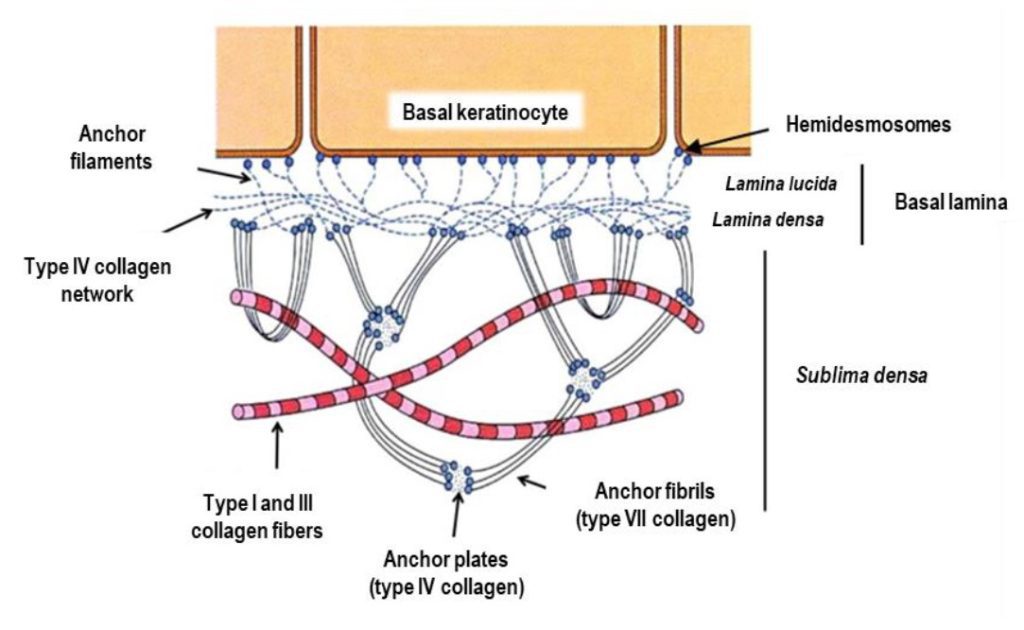

Hemidesmosomes play a fundamental role in anchoring basal keratinocytes to the basal lamina of the epidermis and to the underlying dermis. They are made up of dense plates containing plectins (keratin filament-binding protein) and intermediate plates containing integrins (cell adhesion receptor). These multi-protein complexes secure adhesion of the epidermis and allow it to effectively resist various mechanical stresses coming from the outside.
From an ultrastructural point of view, the epidermal basal lamina appears as two distinct and superimposed layers: the lamina lucida and the lamina densa. These two layers anchor the epidermis to the dermis.
– The lamina lucida in the basement membrane is crossed by laminin-rich anchoring filaments that bind to integrin molecules in hemidesmosomes.
– The lamina densa constitutes an intermediate anchoring zone for filaments from the epidermis and anchoring fibrils from the fibrillar zone of the papillary dermis. It is mainly composed of type IV collagen and laminins. Type IV collagen does not form fibrils, but polymerizes as a network (figure 3). The assembly of this network is responsible for the basal lamina’s tissue support functions and flexibility properties. Moreover, the links established between collagen IV and integrin help maintain the DEJ’s structural integrity.
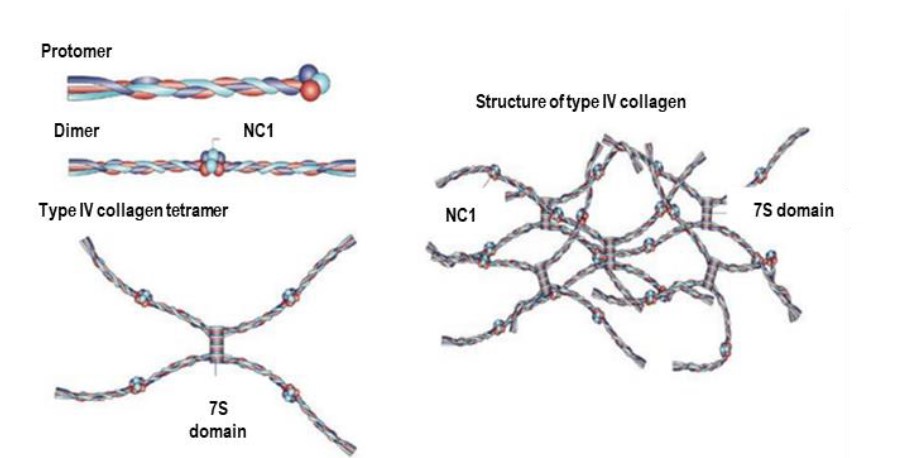

The last zone of the DEJ, the sub-basal fibrillar zone, or sublima densa, is continuous with the underlying dermis. It is essentially made up of anchoring fibrils whose main component is type VII collagen. These anchoring fibrils project from the lamina densa into the upper regions of the papillary dermis where they form semicircular loops around type I and III collagen fibers. These loops are then reinserted into the lamina densa or combined with other structures in the dermis called anchor plaques, which are made of collagen IV. The complex organization of these protein structures strengthens basal lamina anchoring to the underlying dermis, improving communication between the cells of the dermis and the epidermis.
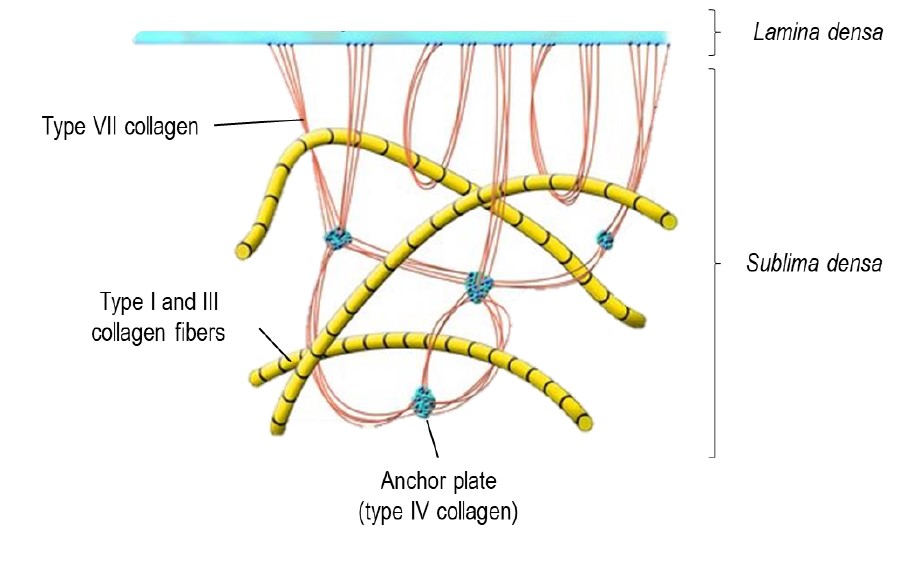

2/ Dermo-epidermal junction function
The DEJ is the interface between the dermis and the epidermis, which allows it to perform a set of fundamental biological functions such as:
– Providing mechanical support for epidermis adhesion to the dermis
– Controlling metabolic exchanges between the two skin layers, in particular by regulating basal membrane permeability
– Determining the polarity of basal keratinocytes, the spatial organization of keratinocytes and thus the structure of the epidermis. During epidermal stratification, the proliferating keratinocytes remain attached to the basement membrane and the generated daughter cells migrate outward into the upper layers of the epidermis
– Providing migratory support for keratinocytes during inflammatory processes or during re-epithelialization as wounds heal
– Forming a reservoir of growth factors
3/ Signs of aging in the dermal-epidermal junction
During skin aging, the DEJ’s initial wavelike surface tends to flatten. The dermal papillae that create indentations in the DEJ decrease with age. This leads to a decrease in the exchange area and the anchoring area between the epidermis and dermis. The DEJ’s mechanical resistance decreases, resulting in a loss of firmness, sagging facial contours and wrinkles. Healing and tissue regeneration processes are also impaired.
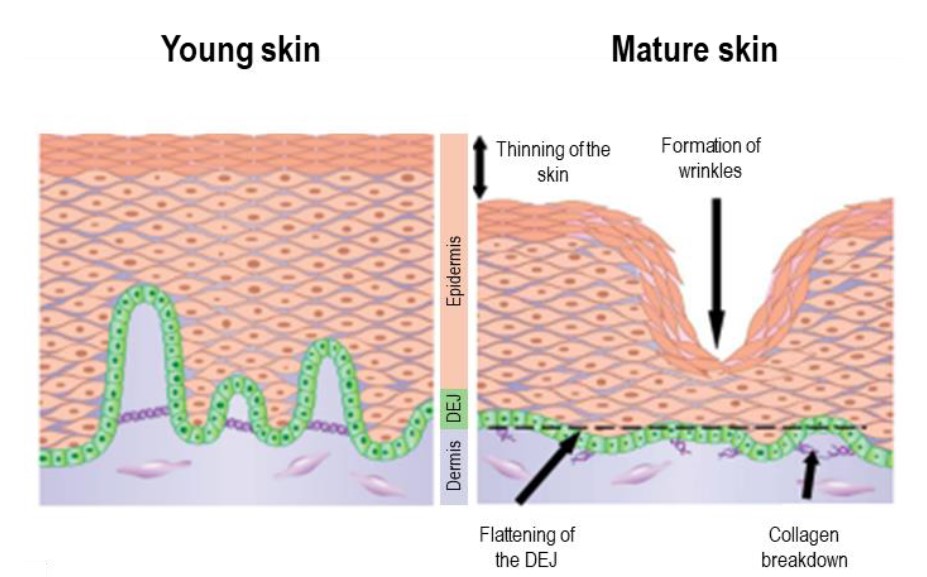

The flattening of the DEJ is accompanied by an inevitable degradation of type IV and VII collagens. The loss of collagen IV leads to thinning of the lamina densa as well as alterations in the anchoring fibrils. It can thus affect the mechanical stability of the DEJ and contribute to the formation of wrinkles. The loss of collagen VII leads to a decrease in anchoring fibrils and therefore a loss of epidermis/dermis connection, thus explaining the appearance of wrinkles.
In addition, recent studies have also identified an important role for type VII collagen in basement membrane formation and re-epithelialization during wound healing. Therefore, levels of type IV and VII collagens that decrease with age must be restored to keep the DEJ in an optimal physiological state.
The dermis is the dense, fibro-elastic support tissue responsible for the skin’s suppleness, elasticity and hydration. It is highly vascularized and essential for epidermal thermoregulation, healing and nutrition.
1/ Structure of the dermis
Histologically, it is possible to divide the dermis into two distinct regions:
– The superficial or papillary dermis, which is in direct contact with the epidermis. In this zone, collagen fibers and small diameter elastic fibers are oriented perpendicular to the DEJ.
– The deep or reticular dermis alone represents 80% of the total thickness of the dermis. Elastin and collagen fibers are large in diameter and are arranged in a multidirectional manner parallel to the skin’s surface. The deeper you go in the dermis, the denser the network of fibers.
The dermis is composed mainly of fibroblasts surrounded by an abundant extracellular matrix (ECM). Biosynthesis occurs in fibroblasts as well as degradation of collagen (90%) and elastin (2 to 4%), the main macromolecules that make up the ECM.
Collagen is therefore the most abundant protein in human skin by far. Type I collagen represents 60% to 80% of the collagens in the dermis and hypodermis, while type III collagen accounts for 15% to 25%. The proportion of type I and III collagen is very important to ensure tissue’s mechanical function.
2/ Signs of aging in the dermis
With age, profound disorganization progressively occurs in the dermis. Alterations in collagen fibers and elastic material, as well as changes in proteoglycan content, are the main characteristics of dermal aging.
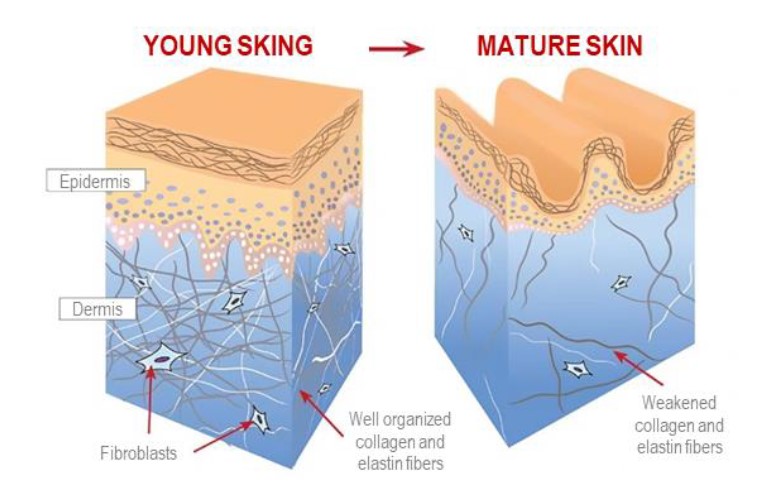

Aging specifically affects the synthesis of type I and III collagen, as well as their proportion. The total collagen content decreases with age, especially type III collagen. This results in an increase in the type I/III ratio, which negatively impacts skin elasticity and healing. The type I/III ratio plays a decisive role in the scar formation process. Pathological scarring processes are systematically associated with a high type I/III ratio, while a low ratio leads to a regenerative process (scarless healing).
In addition, aging induces an increase in the activity of certain proteolytic enzymes (MMP-1, MMP-2 and MMP-9) involved in collagen fiber degradation, as well as a decrease in the expression of TIMPs (Tissue Inhibitor Matrix Protease), inhibitors of these proteolytic enzymes. This relative increase in proteolytic activity leads to an overall decrease in the thickness of the papillary dermis as collagen fibers separate and orient themselves parallel to the DEJ.
Therefore, to counteract these signs of dermal aging, it is important to reactivate matrix macromolecule production in order to improve skin tone and thus reduce wrinkles and sagging skin.
All living beings on our planet are the product of extraordinary and complex mutations. Just like them, the collagen in our skin has evolved over the centuries, becoming increasingly differentiated into 28 types of collagen in humans. Each type of collagen has specific biological functions that are essential to the skin, as detailed in the findings section of this report. In order to take advantage of all the benefits of collagen, it is important to look at its different types.
Collagène Originel is a true collagen specialist that acts on the 4 main types of collagen to redensify the skin in 3 dimensions. It is based on two lines of research precisely focused on restructuring the skin. First, it acts on dermal-epidermal junction (DEJ) cohesion thanks to Type-0 Collagen, a patented Biologique Recherche active ingredient derived from marine biotechnology, and to Silene extract. They promote the expression of collagens IV & VII that make up the DEJ to restructure it and improve its function as a cell anchoring platform. It lengthens and regains its wavelike structure, increasing the contact area between the dermis and the epidermis. The dermal-epidermal exchanges that decrease with age are restarted. Second, it increases the density of the dermal layer with Soybean glycopeptides and Green microalgae. It stimulates collagen I & III, the two most abundant types in the skin, to strengthen its resilience and improve its firmness.
Deep regeneration makes skin tighter and smoother. Its filling effect plumps up deep wrinkles and folds by significantly reducing their length. Recommended for Skin Instants© with established wrinkles.
Active Ingredients
COLLAGEN VII
Type-0 Collagen (exclusive patented Biologique Recherche active ingredient)
Type-0 Collagen is derived from marine biotechnology. It stimulates collagen production at the gene and protein levels. It mainly targets type VII collagen, reinforcing the anchoring of cells to the basal lamina and thus restarting the dermis/epidermis interactions that decrease with age. It helps regenerate the dermis (by increasing synthesis of dermal components) and the epidermis (by promoting keratinocyte proliferation and growth). This restructures skin and rebuilds its firmness. The appearance of wrinkles is reduced.
COLLAGEN IV
Extract of Silene
Silene is a rare and delicate Mediterranean plant, with extremely fine flowers. Its extract counteracts the effects of chronological and biological aging by helping skin regain the biomechanical properties of younger skin. It promotes the expression of proteins that make up the dermal-epidermal junction (DEJ): collagen IV, laminin 5 and tenascin 4. These collagens increase the length of the DEJ and restore its wavelike structure, which is characteristic of young skin. This extract also works in the dermis by stimulating production of collagen I and III to restore skin firmness. The skin is tighter and wrinkles (nasolabial folds) are reduced.
COLLAGEN III
Green microalgae: This green microalgae extract is rich in proteins and essential nutrients. It stimulates the major components of the dermis (collagen I & III, elastin) and prevents them from degrading so the dermis regains all its density, thereby restoring skin tone and firmness. It also promotes the expression of dermal-epidermal junction components (collagen IV & VII, laminins 4 & 5) to ensure good cohesion between the epidermis and the dermis.
COLLAGEN I
Soybean glycopeptides: Soybean glycopeptides boost the synthesis of collagen I to consolidate the dermal layer. Collagen I is the most abundant type of collagen in the body; it is the structural support of the dermis. By boosting its synthesis, this active ingredient strengthens the skin’s resilience and density. The skin’s micro surface is smoothed and wrinkles are minimized.
Benefits
The Serum A-Glyca is a genuinely innovative serum that targets the glycation reaction (which causes wrinkles and premature skin aging). Due to its formula that is rich in anti-glycation active ingredients (mimosa and carcinine), it prevents this phenomenon by way of substitution but also reverses it through deglycation.
Our body needs glucose found in sugars to produce energy. However, glucose isn’t fully utilized by the body. Some bonds directly to proteins, such as collagen and elastin, during the glycation process. This reaction results in Advanced Glycation end-Products (AGE), which are responsible for skin aging.
Active Ingredients
Mimosa extract (Albizia)
The Mimosa, or Albizia julibrissin, produces vaporous flowers all summer long and whose silky
appearance has earned it the nickname of “Silk tree”. It has the ability to protect and repair
protein structures damaged by glycation while supporting the activity of specific detoxification
systems. It reduces glycation while maintaining the activity of the proteasome, therefore giving
it firming and complexion-enhancing properties.
Carcinine
Carcinine, or Decarboxy Carnosine HCL, is a derivative of Carnosine (natural antioxidant) which
has anti-glycation and antioxidant properties. This peptide inactivates the glycated proteins with
the dihydroxyacetone, thus reducing the glycation of proteins and the formation of AGEs, and
forms harmless products which are quickly eliminated by the body. This active ingredient has a
dual action which is firstly preventive by “trapping” the glucose and secondly curative by
replacing the collagen through a transglycation mechanism.
Crème Collagène restructures and intensely moisturizes the skin to regenerate it. Its formula is based on a combination of active ingredients running across 3 action platforms to address the specific needs of dehydrated and altered Skin Instants©.
Its redensifying platform helps stimulate collagen synthesis to restore the structure of the dermis. At its core is a collagen segment, the purpose of which is to support and contribute to restructuring the dermis. Day after day, the skin is firmer and more toned.
The cream’s second platform focuses on moisturizing the skin. It enhances its barrier function to prevent water loss while boosting its hydration. As a result, the skin is immediately moisturized. Lastly, its regenerating platform helps rebalance the skin and combat cutaneous aging.
As a result of these various actions, this skincare product helps tighten tissues to make the skin look smoother. Its light texture is also suitable for seborrhea-prone skin.
Active Ingredients
Collagen segment
This active ingredient is a tripeptide made by sequencing collagen. By stimulating fibroblasts, it helps boost collagen synthesis. It also induces the synthesis of macromolecules in the connective tissue of the dermis, glycosaminoglycans (GAG), such as hyaluronic acid. As a result, it contributes to restructuring and thickening the dermis, while also improving its elasticity, firmness and hydration. It therefore helps restore epidermis that has been damaged by age, the sun or the environment. The skin is smoother and softer, while wrinkles are minimized.
Soybean glycopeptides
Soybean glycopeptides boost the synthesis of collagen I to consolidate the dermal layer. Collagen I is the most abundant type of collagen in the body; it is the structural support of the dermis. By boosting its synthesis, this active ingredient strengthens the skin’s resilience and density. The skin’s microsurface is smoothed and wrinkles are minimized.